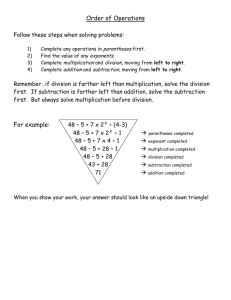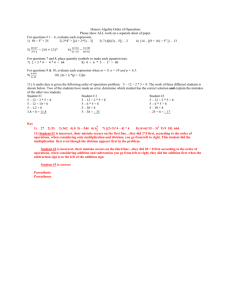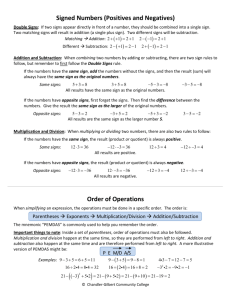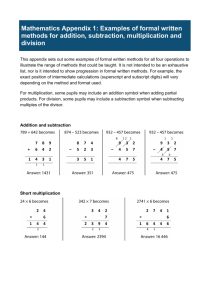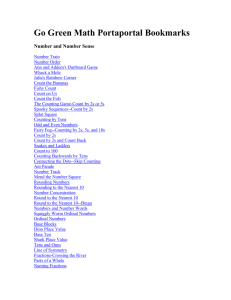SECOND GRADE MATH Goal The second grade mathematics
advertisement
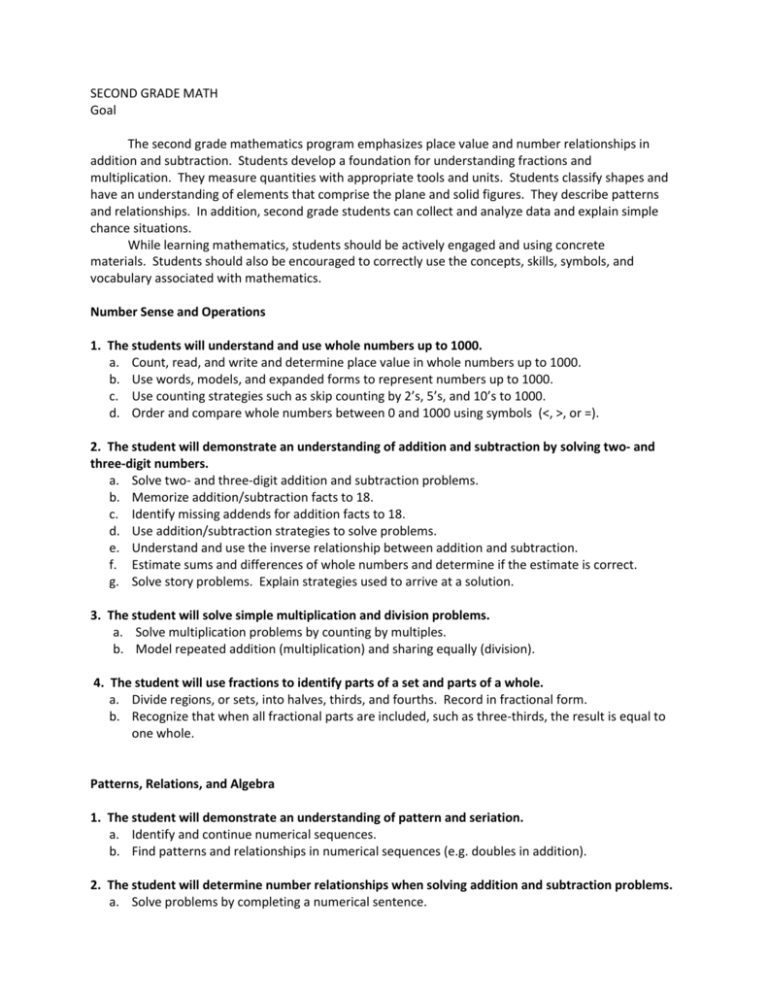
SECOND GRADE MATH Goal The second grade mathematics program emphasizes place value and number relationships in addition and subtraction. Students develop a foundation for understanding fractions and multiplication. They measure quantities with appropriate tools and units. Students classify shapes and have an understanding of elements that comprise the plane and solid figures. They describe patterns and relationships. In addition, second grade students can collect and analyze data and explain simple chance situations. While learning mathematics, students should be actively engaged and using concrete materials. Students should also be encouraged to correctly use the concepts, skills, symbols, and vocabulary associated with mathematics. Number Sense and Operations 1. The students will understand and use whole numbers up to 1000. a. Count, read, and write and determine place value in whole numbers up to 1000. b. Use words, models, and expanded forms to represent numbers up to 1000. c. Use counting strategies such as skip counting by 2’s, 5’s, and 10’s to 1000. d. Order and compare whole numbers between 0 and 1000 using symbols (<, >, or =). 2. The student will demonstrate an understanding of addition and subtraction by solving two- and three-digit numbers. a. Solve two- and three-digit addition and subtraction problems. b. Memorize addition/subtraction facts to 18. c. Identify missing addends for addition facts to 18. d. Use addition/subtraction strategies to solve problems. e. Understand and use the inverse relationship between addition and subtraction. f. Estimate sums and differences of whole numbers and determine if the estimate is correct. g. Solve story problems. Explain strategies used to arrive at a solution. 3. The student will solve simple multiplication and division problems. a. Solve multiplication problems by counting by multiples. b. Model repeated addition (multiplication) and sharing equally (division). 4. The student will use fractions to identify parts of a set and parts of a whole. a. Divide regions, or sets, into halves, thirds, and fourths. Record in fractional form. b. Recognize that when all fractional parts are included, such as three-thirds, the result is equal to one whole. Patterns, Relations, and Algebra 1. The student will demonstrate an understanding of pattern and seriation. a. Identify and continue numerical sequences. b. Find patterns and relationships in numerical sequences (e.g. doubles in addition). 2. The student will determine number relationships when solving addition and subtraction problems. a. Solve problems by completing a numerical sentence. b. Use the commutative and associate rules. c. Solve addition and subtraction problems using data from simple charts, picture graphs, and number sentences. Geometry 1. The student will identify common geometric figures and classify them by common attributes. a. Identify, describe, and classify plane and solid geometric shapes according to the number and shape of faces, edges, and vertices. b. Compare and contrast plane and solid figures (e.g. circle/sphere, square/cube, triangle/pyramid, rectangle/rectangular solid). c. Identify and create congruent figures. 2. The student will describe the relative position of objects. a. Identify shapes that have been rotated (turned), reflected (flipped), translated (slid) and enlarged. b. Identify symmetry in two-dimensional shapes. Measurement 1. The student will select an appropriate standard or nonstandard unit to measure objects and solve problems. a. Measure, estimate, and compare objects by size, weight, capacity, and quantity. b. Recognize how to make measurements using standard units (e.g. inches, centimeters, and quarts). c. Use different units to measure the same object. Predict whether the measurement will be greater or smaller when a different unit is used. 2. The student will use measurement in real world applications. a. Tell time to the nearest quarter-hour using digital and analog clocks. b. Read, compare, and record various temperatures. c. Use the cent symbol, the dollar symbol, and the decimal point appropriately when working with money. d. Count, compare, and make change using coins and one-dollar bills. e. Make and use estimates of measurement. Data Analysis, Statistics, and Probability 1. The student will demonstrate an understanding of data collection, display, and interpretation. a. Collect, record, organize, display, and interpret information in various ways, such as charts, graphs, and tables (with correct labeling). b. Ask and answer simple questions related to data representations. 2. The student will explore probability. a. Complete simple probability experiments. b. Predict the outcome of probability experiments.

